Business and Environment: Organisation, Functions, PESTEL Analysis
VerifiedAdded on 2024/05/29
|13
|4137
|422
Essay
AI Summary
This essay discusses different types of organisations, including non-governmental, non-profit, and profit-oriented entities, along with their structures, scopes, and functions. It explores the interrelationships within organisations, highlighting examples such as Tesco, HSBC, and UNICEF. The essay also delves into the differences between micro, small, medium, and large enterprises, examining their operational scopes and organisational structures like matrix, functional, product, customer, and geographic structures. Furthermore, it applies PESTEL analysis to evaluate the positive and negative effects of the macro environment on the UK retail sector, considering political and economic factors such as Brexit. The competitive forces affecting UK supermarkets are also discussed, providing a comprehensive overview of the business and business environment. Desklib offers a platform to access similar solved assignments and past papers for students.
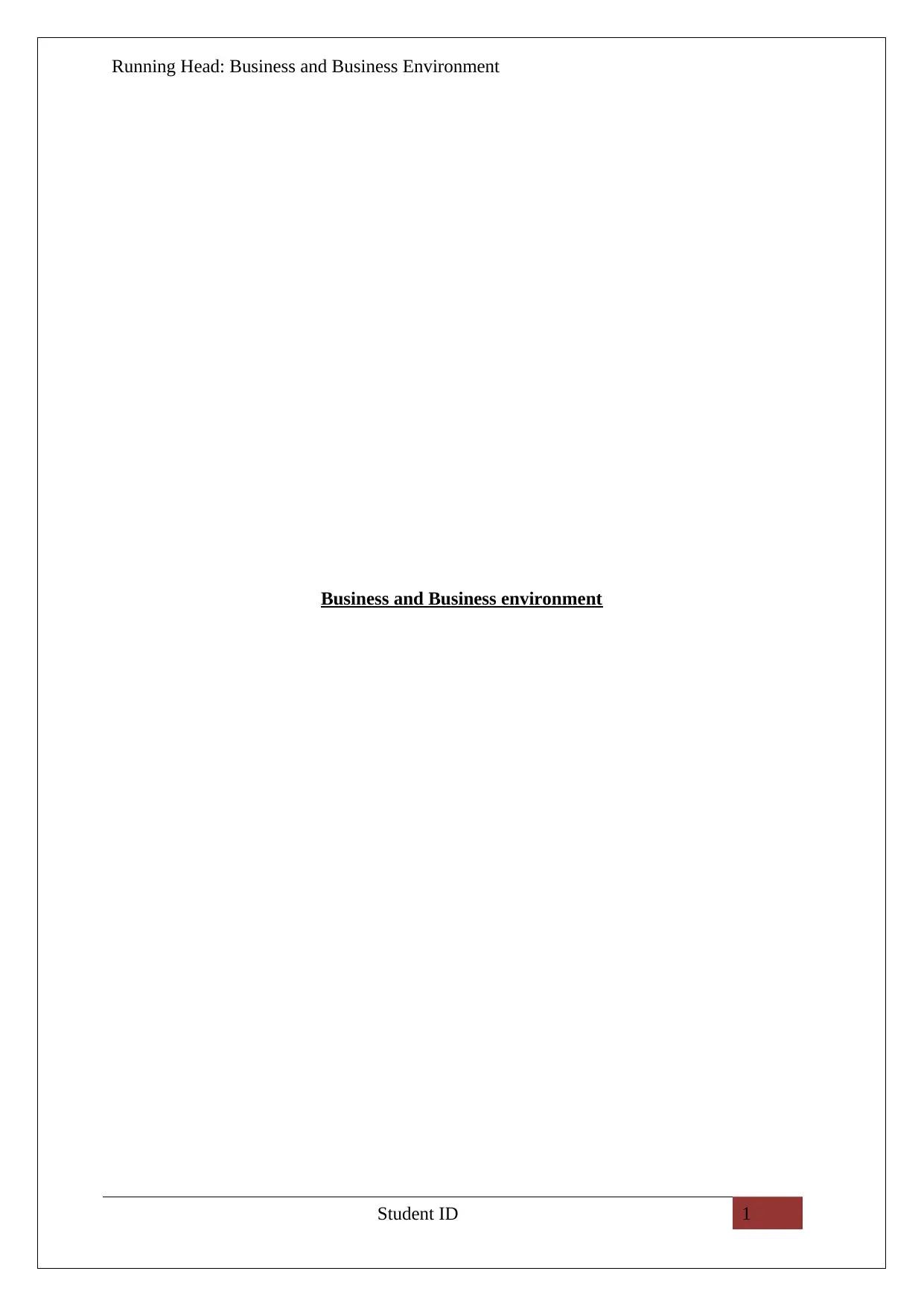
Running Head: Business and Business Environment
Business and Business environment
Student ID 1
Business and Business environment
Student ID 1
Paraphrase This Document
Need a fresh take? Get an instant paraphrase of this document with our AI Paraphraser
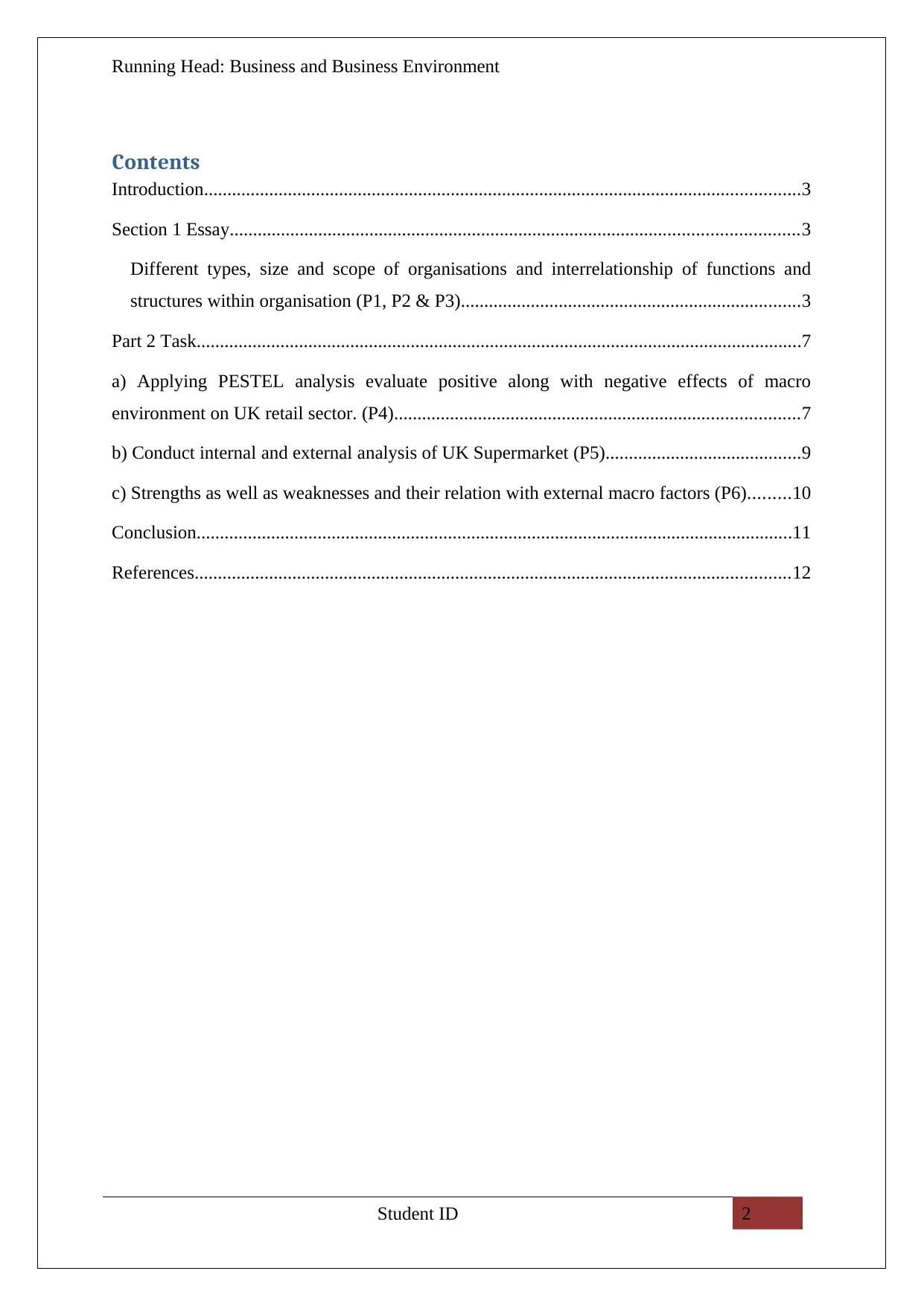
Running Head: Business and Business Environment
Contents
Introduction................................................................................................................................3
Section 1 Essay..........................................................................................................................3
Different types, size and scope of organisations and interrelationship of functions and
structures within organisation (P1, P2 & P3).........................................................................3
Part 2 Task..................................................................................................................................7
a) Applying PESTEL analysis evaluate positive along with negative effects of macro
environment on UK retail sector. (P4).......................................................................................7
b) Conduct internal and external analysis of UK Supermarket (P5)..........................................9
c) Strengths as well as weaknesses and their relation with external macro factors (P6).........10
Conclusion................................................................................................................................11
References................................................................................................................................12
Student ID 2
Contents
Introduction................................................................................................................................3
Section 1 Essay..........................................................................................................................3
Different types, size and scope of organisations and interrelationship of functions and
structures within organisation (P1, P2 & P3).........................................................................3
Part 2 Task..................................................................................................................................7
a) Applying PESTEL analysis evaluate positive along with negative effects of macro
environment on UK retail sector. (P4).......................................................................................7
b) Conduct internal and external analysis of UK Supermarket (P5)..........................................9
c) Strengths as well as weaknesses and their relation with external macro factors (P6).........10
Conclusion................................................................................................................................11
References................................................................................................................................12
Student ID 2
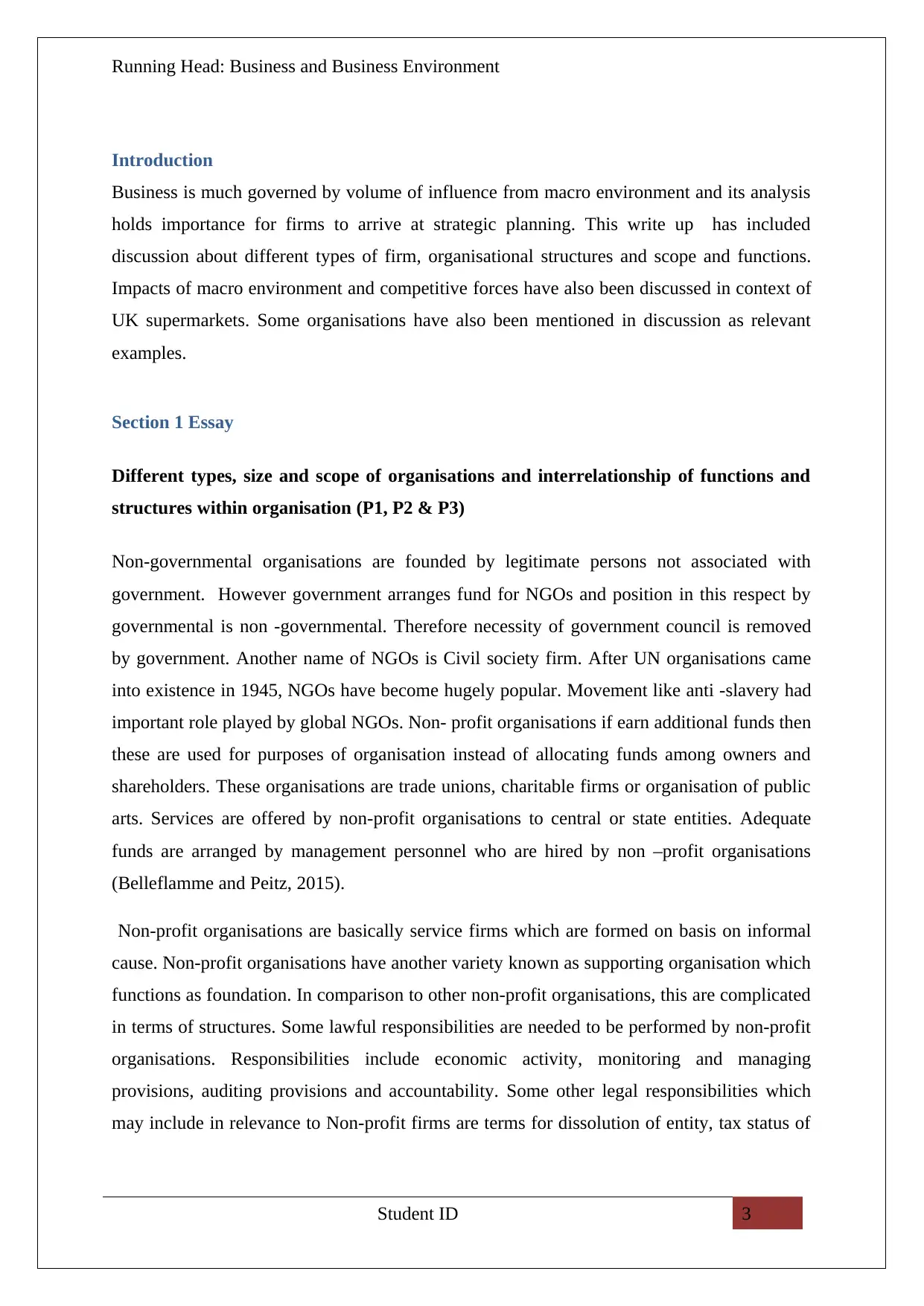
Running Head: Business and Business Environment
Introduction
Business is much governed by volume of influence from macro environment and its analysis
holds importance for firms to arrive at strategic planning. This write up has included
discussion about different types of firm, organisational structures and scope and functions.
Impacts of macro environment and competitive forces have also been discussed in context of
UK supermarkets. Some organisations have also been mentioned in discussion as relevant
examples.
Section 1 Essay
Different types, size and scope of organisations and interrelationship of functions and
structures within organisation (P1, P2 & P3)
Non-governmental organisations are founded by legitimate persons not associated with
government. However government arranges fund for NGOs and position in this respect by
governmental is non -governmental. Therefore necessity of government council is removed
by government. Another name of NGOs is Civil society firm. After UN organisations came
into existence in 1945, NGOs have become hugely popular. Movement like anti -slavery had
important role played by global NGOs. Non- profit organisations if earn additional funds then
these are used for purposes of organisation instead of allocating funds among owners and
shareholders. These organisations are trade unions, charitable firms or organisation of public
arts. Services are offered by non-profit organisations to central or state entities. Adequate
funds are arranged by management personnel who are hired by non –profit organisations
(Belleflamme and Peitz, 2015).
Non-profit organisations are basically service firms which are formed on basis on informal
cause. Non-profit organisations have another variety known as supporting organisation which
functions as foundation. In comparison to other non-profit organisations, this are complicated
in terms of structures. Some lawful responsibilities are needed to be performed by non-profit
organisations. Responsibilities include economic activity, monitoring and managing
provisions, auditing provisions and accountability. Some other legal responsibilities which
may include in relevance to Non-profit firms are terms for dissolution of entity, tax status of
Student ID 3
Introduction
Business is much governed by volume of influence from macro environment and its analysis
holds importance for firms to arrive at strategic planning. This write up has included
discussion about different types of firm, organisational structures and scope and functions.
Impacts of macro environment and competitive forces have also been discussed in context of
UK supermarkets. Some organisations have also been mentioned in discussion as relevant
examples.
Section 1 Essay
Different types, size and scope of organisations and interrelationship of functions and
structures within organisation (P1, P2 & P3)
Non-governmental organisations are founded by legitimate persons not associated with
government. However government arranges fund for NGOs and position in this respect by
governmental is non -governmental. Therefore necessity of government council is removed
by government. Another name of NGOs is Civil society firm. After UN organisations came
into existence in 1945, NGOs have become hugely popular. Movement like anti -slavery had
important role played by global NGOs. Non- profit organisations if earn additional funds then
these are used for purposes of organisation instead of allocating funds among owners and
shareholders. These organisations are trade unions, charitable firms or organisation of public
arts. Services are offered by non-profit organisations to central or state entities. Adequate
funds are arranged by management personnel who are hired by non –profit organisations
(Belleflamme and Peitz, 2015).
Non-profit organisations are basically service firms which are formed on basis on informal
cause. Non-profit organisations have another variety known as supporting organisation which
functions as foundation. In comparison to other non-profit organisations, this are complicated
in terms of structures. Some lawful responsibilities are needed to be performed by non-profit
organisations. Responsibilities include economic activity, monitoring and managing
provisions, auditing provisions and accountability. Some other legal responsibilities which
may include in relevance to Non-profit firms are terms for dissolution of entity, tax status of
Student ID 3
⊘ This is a preview!⊘
Do you want full access?
Subscribe today to unlock all pages.

Trusted by 1+ million students worldwide
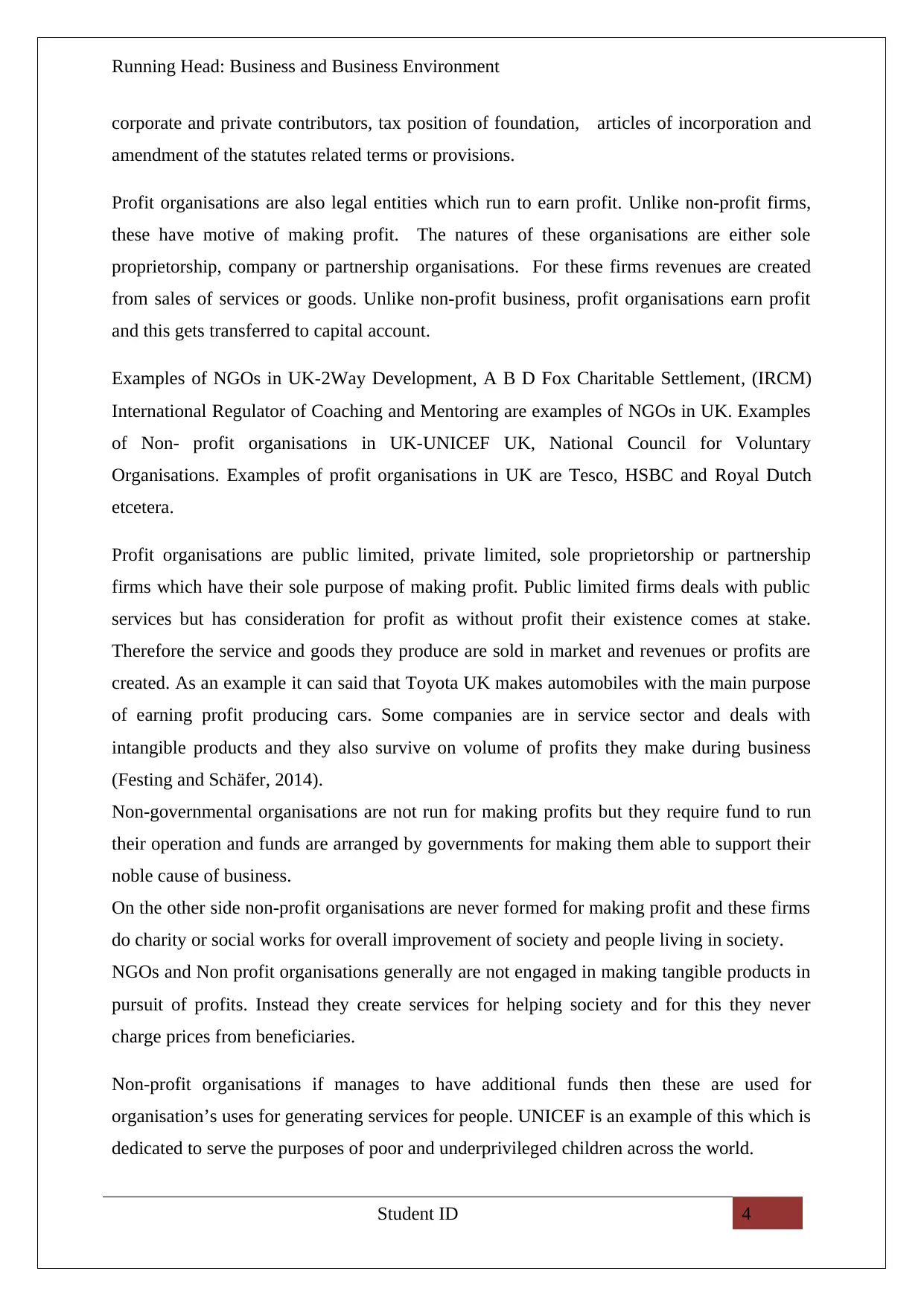
Running Head: Business and Business Environment
corporate and private contributors, tax position of foundation, articles of incorporation and
amendment of the statutes related terms or provisions.
Profit organisations are also legal entities which run to earn profit. Unlike non-profit firms,
these have motive of making profit. The natures of these organisations are either sole
proprietorship, company or partnership organisations. For these firms revenues are created
from sales of services or goods. Unlike non-profit business, profit organisations earn profit
and this gets transferred to capital account.
Examples of NGOs in UK-2Way Development, A B D Fox Charitable Settlement, (IRCM)
International Regulator of Coaching and Mentoring are examples of NGOs in UK. Examples
of Non- profit organisations in UK-UNICEF UK, National Council for Voluntary
Organisations. Examples of profit organisations in UK are Tesco, HSBC and Royal Dutch
etcetera.
Profit organisations are public limited, private limited, sole proprietorship or partnership
firms which have their sole purpose of making profit. Public limited firms deals with public
services but has consideration for profit as without profit their existence comes at stake.
Therefore the service and goods they produce are sold in market and revenues or profits are
created. As an example it can said that Toyota UK makes automobiles with the main purpose
of earning profit producing cars. Some companies are in service sector and deals with
intangible products and they also survive on volume of profits they make during business
(Festing and Schäfer, 2014).
Non-governmental organisations are not run for making profits but they require fund to run
their operation and funds are arranged by governments for making them able to support their
noble cause of business.
On the other side non-profit organisations are never formed for making profit and these firms
do charity or social works for overall improvement of society and people living in society.
NGOs and Non profit organisations generally are not engaged in making tangible products in
pursuit of profits. Instead they create services for helping society and for this they never
charge prices from beneficiaries.
Non-profit organisations if manages to have additional funds then these are used for
organisation’s uses for generating services for people. UNICEF is an example of this which is
dedicated to serve the purposes of poor and underprivileged children across the world.
Student ID 4
corporate and private contributors, tax position of foundation, articles of incorporation and
amendment of the statutes related terms or provisions.
Profit organisations are also legal entities which run to earn profit. Unlike non-profit firms,
these have motive of making profit. The natures of these organisations are either sole
proprietorship, company or partnership organisations. For these firms revenues are created
from sales of services or goods. Unlike non-profit business, profit organisations earn profit
and this gets transferred to capital account.
Examples of NGOs in UK-2Way Development, A B D Fox Charitable Settlement, (IRCM)
International Regulator of Coaching and Mentoring are examples of NGOs in UK. Examples
of Non- profit organisations in UK-UNICEF UK, National Council for Voluntary
Organisations. Examples of profit organisations in UK are Tesco, HSBC and Royal Dutch
etcetera.
Profit organisations are public limited, private limited, sole proprietorship or partnership
firms which have their sole purpose of making profit. Public limited firms deals with public
services but has consideration for profit as without profit their existence comes at stake.
Therefore the service and goods they produce are sold in market and revenues or profits are
created. As an example it can said that Toyota UK makes automobiles with the main purpose
of earning profit producing cars. Some companies are in service sector and deals with
intangible products and they also survive on volume of profits they make during business
(Festing and Schäfer, 2014).
Non-governmental organisations are not run for making profits but they require fund to run
their operation and funds are arranged by governments for making them able to support their
noble cause of business.
On the other side non-profit organisations are never formed for making profit and these firms
do charity or social works for overall improvement of society and people living in society.
NGOs and Non profit organisations generally are not engaged in making tangible products in
pursuit of profits. Instead they create services for helping society and for this they never
charge prices from beneficiaries.
Non-profit organisations if manages to have additional funds then these are used for
organisation’s uses for generating services for people. UNICEF is an example of this which is
dedicated to serve the purposes of poor and underprivileged children across the world.
Student ID 4
Paraphrase This Document
Need a fresh take? Get an instant paraphrase of this document with our AI Paraphraser
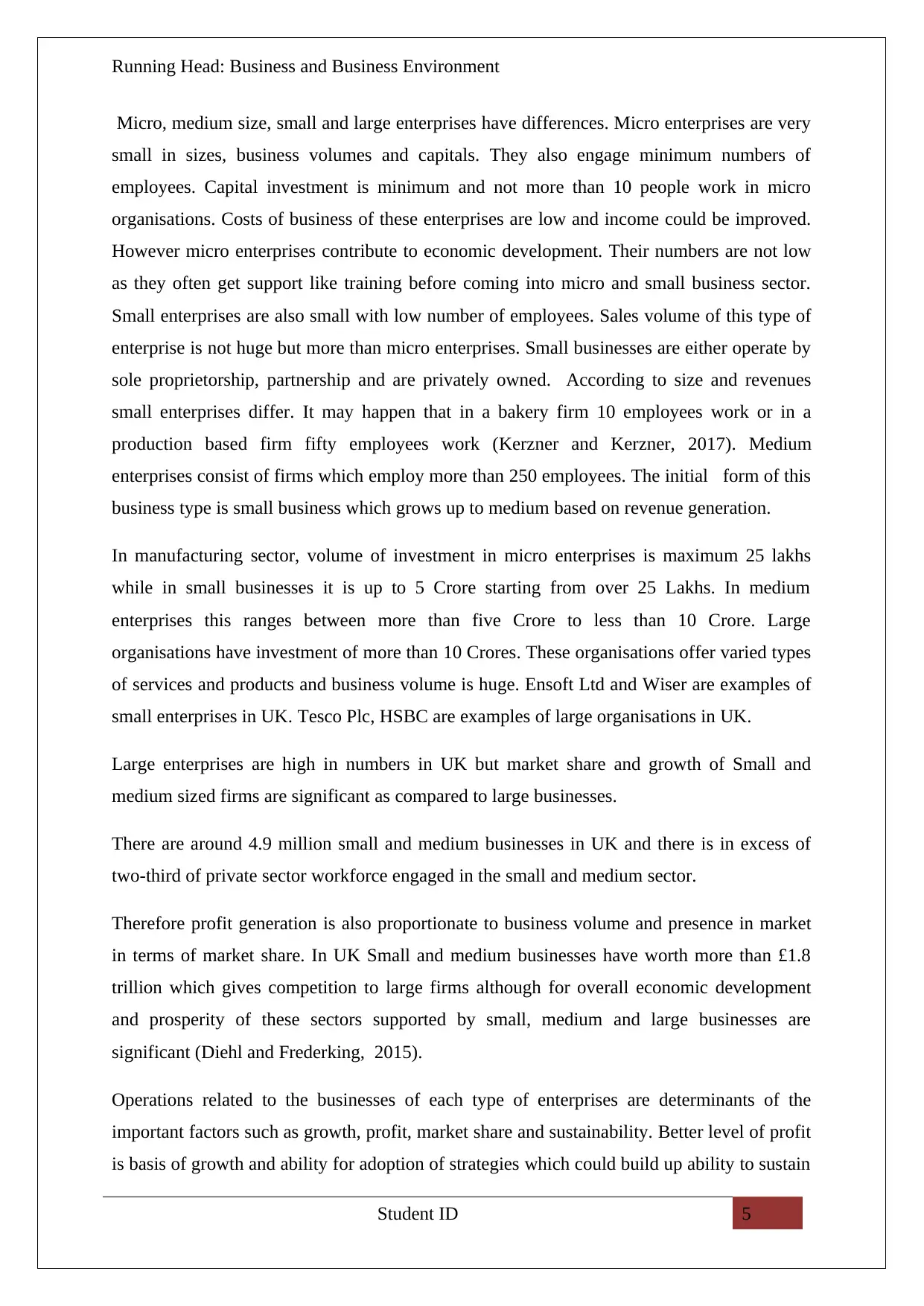
Running Head: Business and Business Environment
Micro, medium size, small and large enterprises have differences. Micro enterprises are very
small in sizes, business volumes and capitals. They also engage minimum numbers of
employees. Capital investment is minimum and not more than 10 people work in micro
organisations. Costs of business of these enterprises are low and income could be improved.
However micro enterprises contribute to economic development. Their numbers are not low
as they often get support like training before coming into micro and small business sector.
Small enterprises are also small with low number of employees. Sales volume of this type of
enterprise is not huge but more than micro enterprises. Small businesses are either operate by
sole proprietorship, partnership and are privately owned. According to size and revenues
small enterprises differ. It may happen that in a bakery firm 10 employees work or in a
production based firm fifty employees work (Kerzner and Kerzner, 2017). Medium
enterprises consist of firms which employ more than 250 employees. The initial form of this
business type is small business which grows up to medium based on revenue generation.
In manufacturing sector, volume of investment in micro enterprises is maximum 25 lakhs
while in small businesses it is up to 5 Crore starting from over 25 Lakhs. In medium
enterprises this ranges between more than five Crore to less than 10 Crore. Large
organisations have investment of more than 10 Crores. These organisations offer varied types
of services and products and business volume is huge. Ensoft Ltd and Wiser are examples of
small enterprises in UK. Tesco Plc, HSBC are examples of large organisations in UK.
Large enterprises are high in numbers in UK but market share and growth of Small and
medium sized firms are significant as compared to large businesses.
There are around 4.9 million small and medium businesses in UK and there is in excess of
two-third of private sector workforce engaged in the small and medium sector.
Therefore profit generation is also proportionate to business volume and presence in market
in terms of market share. In UK Small and medium businesses have worth more than £1.8
trillion which gives competition to large firms although for overall economic development
and prosperity of these sectors supported by small, medium and large businesses are
significant (Diehl and Frederking, 2015).
Operations related to the businesses of each type of enterprises are determinants of the
important factors such as growth, profit, market share and sustainability. Better level of profit
is basis of growth and ability for adoption of strategies which could build up ability to sustain
Student ID 5
Micro, medium size, small and large enterprises have differences. Micro enterprises are very
small in sizes, business volumes and capitals. They also engage minimum numbers of
employees. Capital investment is minimum and not more than 10 people work in micro
organisations. Costs of business of these enterprises are low and income could be improved.
However micro enterprises contribute to economic development. Their numbers are not low
as they often get support like training before coming into micro and small business sector.
Small enterprises are also small with low number of employees. Sales volume of this type of
enterprise is not huge but more than micro enterprises. Small businesses are either operate by
sole proprietorship, partnership and are privately owned. According to size and revenues
small enterprises differ. It may happen that in a bakery firm 10 employees work or in a
production based firm fifty employees work (Kerzner and Kerzner, 2017). Medium
enterprises consist of firms which employ more than 250 employees. The initial form of this
business type is small business which grows up to medium based on revenue generation.
In manufacturing sector, volume of investment in micro enterprises is maximum 25 lakhs
while in small businesses it is up to 5 Crore starting from over 25 Lakhs. In medium
enterprises this ranges between more than five Crore to less than 10 Crore. Large
organisations have investment of more than 10 Crores. These organisations offer varied types
of services and products and business volume is huge. Ensoft Ltd and Wiser are examples of
small enterprises in UK. Tesco Plc, HSBC are examples of large organisations in UK.
Large enterprises are high in numbers in UK but market share and growth of Small and
medium sized firms are significant as compared to large businesses.
There are around 4.9 million small and medium businesses in UK and there is in excess of
two-third of private sector workforce engaged in the small and medium sector.
Therefore profit generation is also proportionate to business volume and presence in market
in terms of market share. In UK Small and medium businesses have worth more than £1.8
trillion which gives competition to large firms although for overall economic development
and prosperity of these sectors supported by small, medium and large businesses are
significant (Diehl and Frederking, 2015).
Operations related to the businesses of each type of enterprises are determinants of the
important factors such as growth, profit, market share and sustainability. Better level of profit
is basis of growth and ability for adoption of strategies which could build up ability to sustain
Student ID 5
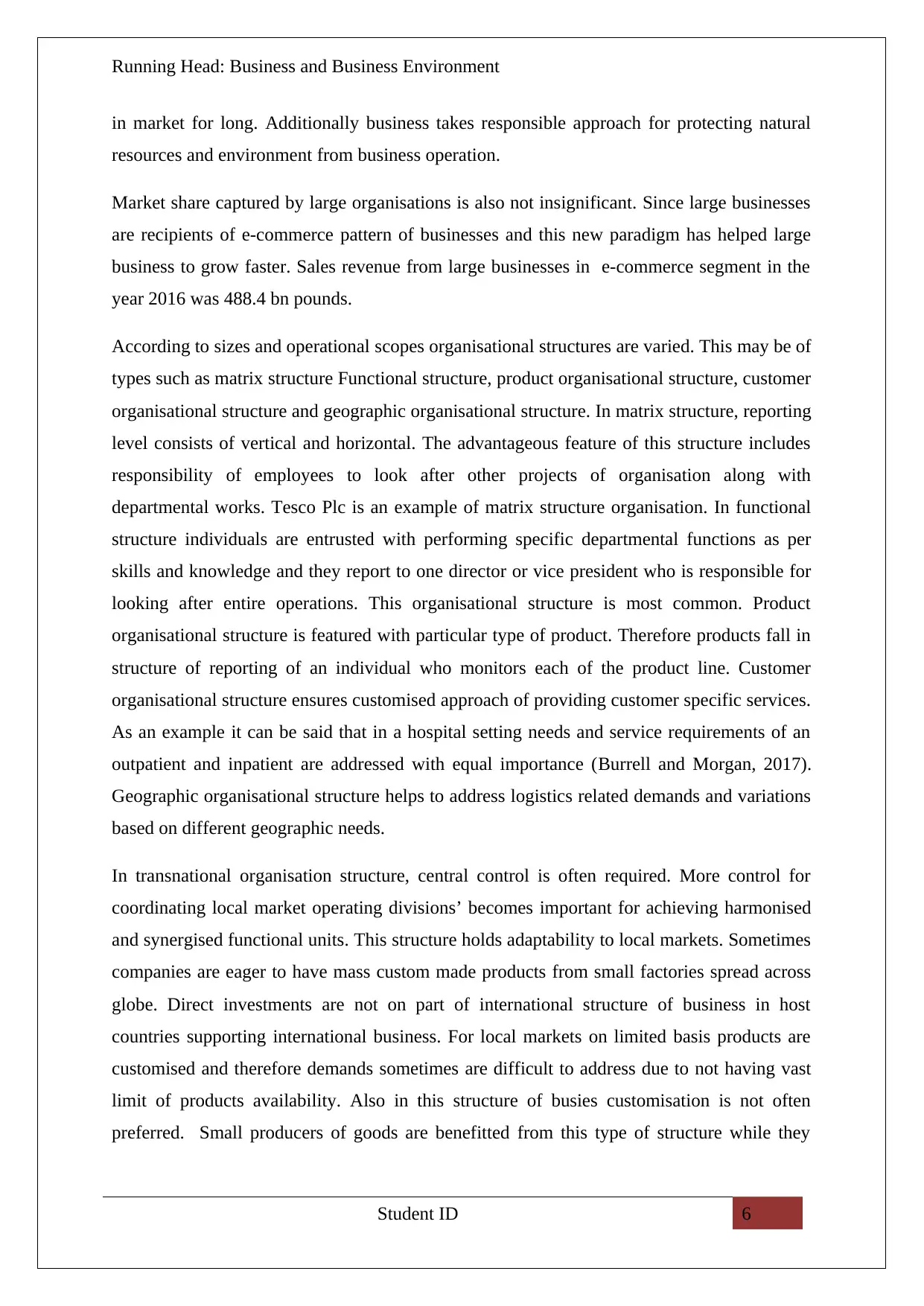
Running Head: Business and Business Environment
in market for long. Additionally business takes responsible approach for protecting natural
resources and environment from business operation.
Market share captured by large organisations is also not insignificant. Since large businesses
are recipients of e-commerce pattern of businesses and this new paradigm has helped large
business to grow faster. Sales revenue from large businesses in e-commerce segment in the
year 2016 was 488.4 bn pounds.
According to sizes and operational scopes organisational structures are varied. This may be of
types such as matrix structure Functional structure, product organisational structure, customer
organisational structure and geographic organisational structure. In matrix structure, reporting
level consists of vertical and horizontal. The advantageous feature of this structure includes
responsibility of employees to look after other projects of organisation along with
departmental works. Tesco Plc is an example of matrix structure organisation. In functional
structure individuals are entrusted with performing specific departmental functions as per
skills and knowledge and they report to one director or vice president who is responsible for
looking after entire operations. This organisational structure is most common. Product
organisational structure is featured with particular type of product. Therefore products fall in
structure of reporting of an individual who monitors each of the product line. Customer
organisational structure ensures customised approach of providing customer specific services.
As an example it can be said that in a hospital setting needs and service requirements of an
outpatient and inpatient are addressed with equal importance (Burrell and Morgan, 2017).
Geographic organisational structure helps to address logistics related demands and variations
based on different geographic needs.
In transnational organisation structure, central control is often required. More control for
coordinating local market operating divisions’ becomes important for achieving harmonised
and synergised functional units. This structure holds adaptability to local markets. Sometimes
companies are eager to have mass custom made products from small factories spread across
globe. Direct investments are not on part of international structure of business in host
countries supporting international business. For local markets on limited basis products are
customised and therefore demands sometimes are difficult to address due to not having vast
limit of products availability. Also in this structure of busies customisation is not often
preferred. Small producers of goods are benefitted from this type of structure while they
Student ID 6
in market for long. Additionally business takes responsible approach for protecting natural
resources and environment from business operation.
Market share captured by large organisations is also not insignificant. Since large businesses
are recipients of e-commerce pattern of businesses and this new paradigm has helped large
business to grow faster. Sales revenue from large businesses in e-commerce segment in the
year 2016 was 488.4 bn pounds.
According to sizes and operational scopes organisational structures are varied. This may be of
types such as matrix structure Functional structure, product organisational structure, customer
organisational structure and geographic organisational structure. In matrix structure, reporting
level consists of vertical and horizontal. The advantageous feature of this structure includes
responsibility of employees to look after other projects of organisation along with
departmental works. Tesco Plc is an example of matrix structure organisation. In functional
structure individuals are entrusted with performing specific departmental functions as per
skills and knowledge and they report to one director or vice president who is responsible for
looking after entire operations. This organisational structure is most common. Product
organisational structure is featured with particular type of product. Therefore products fall in
structure of reporting of an individual who monitors each of the product line. Customer
organisational structure ensures customised approach of providing customer specific services.
As an example it can be said that in a hospital setting needs and service requirements of an
outpatient and inpatient are addressed with equal importance (Burrell and Morgan, 2017).
Geographic organisational structure helps to address logistics related demands and variations
based on different geographic needs.
In transnational organisation structure, central control is often required. More control for
coordinating local market operating divisions’ becomes important for achieving harmonised
and synergised functional units. This structure holds adaptability to local markets. Sometimes
companies are eager to have mass custom made products from small factories spread across
globe. Direct investments are not on part of international structure of business in host
countries supporting international business. For local markets on limited basis products are
customised and therefore demands sometimes are difficult to address due to not having vast
limit of products availability. Also in this structure of busies customisation is not often
preferred. Small producers of goods are benefitted from this type of structure while they
Student ID 6
⊘ This is a preview!⊘
Do you want full access?
Subscribe today to unlock all pages.

Trusted by 1+ million students worldwide
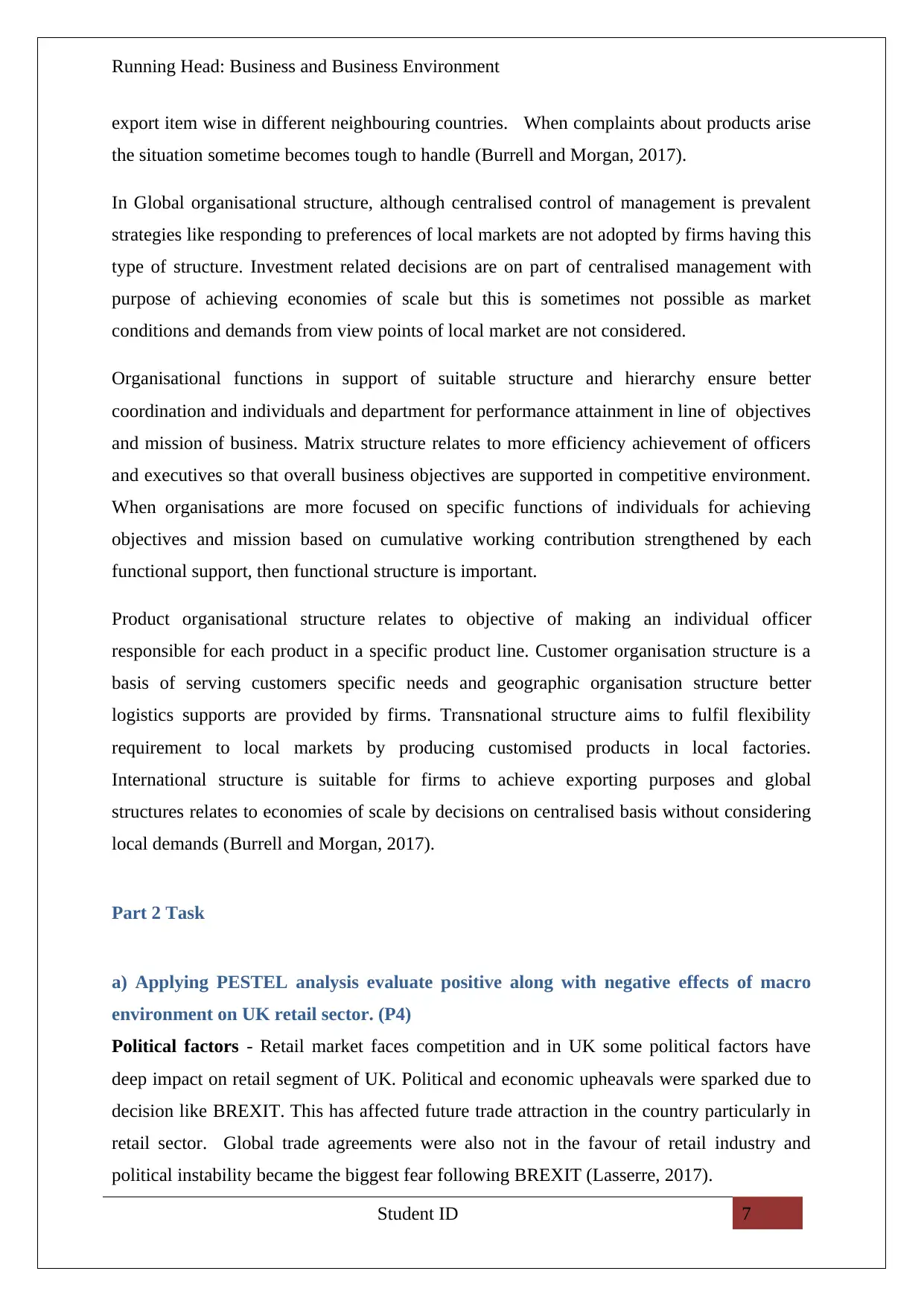
Running Head: Business and Business Environment
export item wise in different neighbouring countries. When complaints about products arise
the situation sometime becomes tough to handle (Burrell and Morgan, 2017).
In Global organisational structure, although centralised control of management is prevalent
strategies like responding to preferences of local markets are not adopted by firms having this
type of structure. Investment related decisions are on part of centralised management with
purpose of achieving economies of scale but this is sometimes not possible as market
conditions and demands from view points of local market are not considered.
Organisational functions in support of suitable structure and hierarchy ensure better
coordination and individuals and department for performance attainment in line of objectives
and mission of business. Matrix structure relates to more efficiency achievement of officers
and executives so that overall business objectives are supported in competitive environment.
When organisations are more focused on specific functions of individuals for achieving
objectives and mission based on cumulative working contribution strengthened by each
functional support, then functional structure is important.
Product organisational structure relates to objective of making an individual officer
responsible for each product in a specific product line. Customer organisation structure is a
basis of serving customers specific needs and geographic organisation structure better
logistics supports are provided by firms. Transnational structure aims to fulfil flexibility
requirement to local markets by producing customised products in local factories.
International structure is suitable for firms to achieve exporting purposes and global
structures relates to economies of scale by decisions on centralised basis without considering
local demands (Burrell and Morgan, 2017).
Part 2 Task
a) Applying PESTEL analysis evaluate positive along with negative effects of macro
environment on UK retail sector. (P4)
Political factors - Retail market faces competition and in UK some political factors have
deep impact on retail segment of UK. Political and economic upheavals were sparked due to
decision like BREXIT. This has affected future trade attraction in the country particularly in
retail sector. Global trade agreements were also not in the favour of retail industry and
political instability became the biggest fear following BREXIT (Lasserre, 2017).
Student ID 7
export item wise in different neighbouring countries. When complaints about products arise
the situation sometime becomes tough to handle (Burrell and Morgan, 2017).
In Global organisational structure, although centralised control of management is prevalent
strategies like responding to preferences of local markets are not adopted by firms having this
type of structure. Investment related decisions are on part of centralised management with
purpose of achieving economies of scale but this is sometimes not possible as market
conditions and demands from view points of local market are not considered.
Organisational functions in support of suitable structure and hierarchy ensure better
coordination and individuals and department for performance attainment in line of objectives
and mission of business. Matrix structure relates to more efficiency achievement of officers
and executives so that overall business objectives are supported in competitive environment.
When organisations are more focused on specific functions of individuals for achieving
objectives and mission based on cumulative working contribution strengthened by each
functional support, then functional structure is important.
Product organisational structure relates to objective of making an individual officer
responsible for each product in a specific product line. Customer organisation structure is a
basis of serving customers specific needs and geographic organisation structure better
logistics supports are provided by firms. Transnational structure aims to fulfil flexibility
requirement to local markets by producing customised products in local factories.
International structure is suitable for firms to achieve exporting purposes and global
structures relates to economies of scale by decisions on centralised basis without considering
local demands (Burrell and Morgan, 2017).
Part 2 Task
a) Applying PESTEL analysis evaluate positive along with negative effects of macro
environment on UK retail sector. (P4)
Political factors - Retail market faces competition and in UK some political factors have
deep impact on retail segment of UK. Political and economic upheavals were sparked due to
decision like BREXIT. This has affected future trade attraction in the country particularly in
retail sector. Global trade agreements were also not in the favour of retail industry and
political instability became the biggest fear following BREXIT (Lasserre, 2017).
Student ID 7
Paraphrase This Document
Need a fresh take? Get an instant paraphrase of this document with our AI Paraphraser
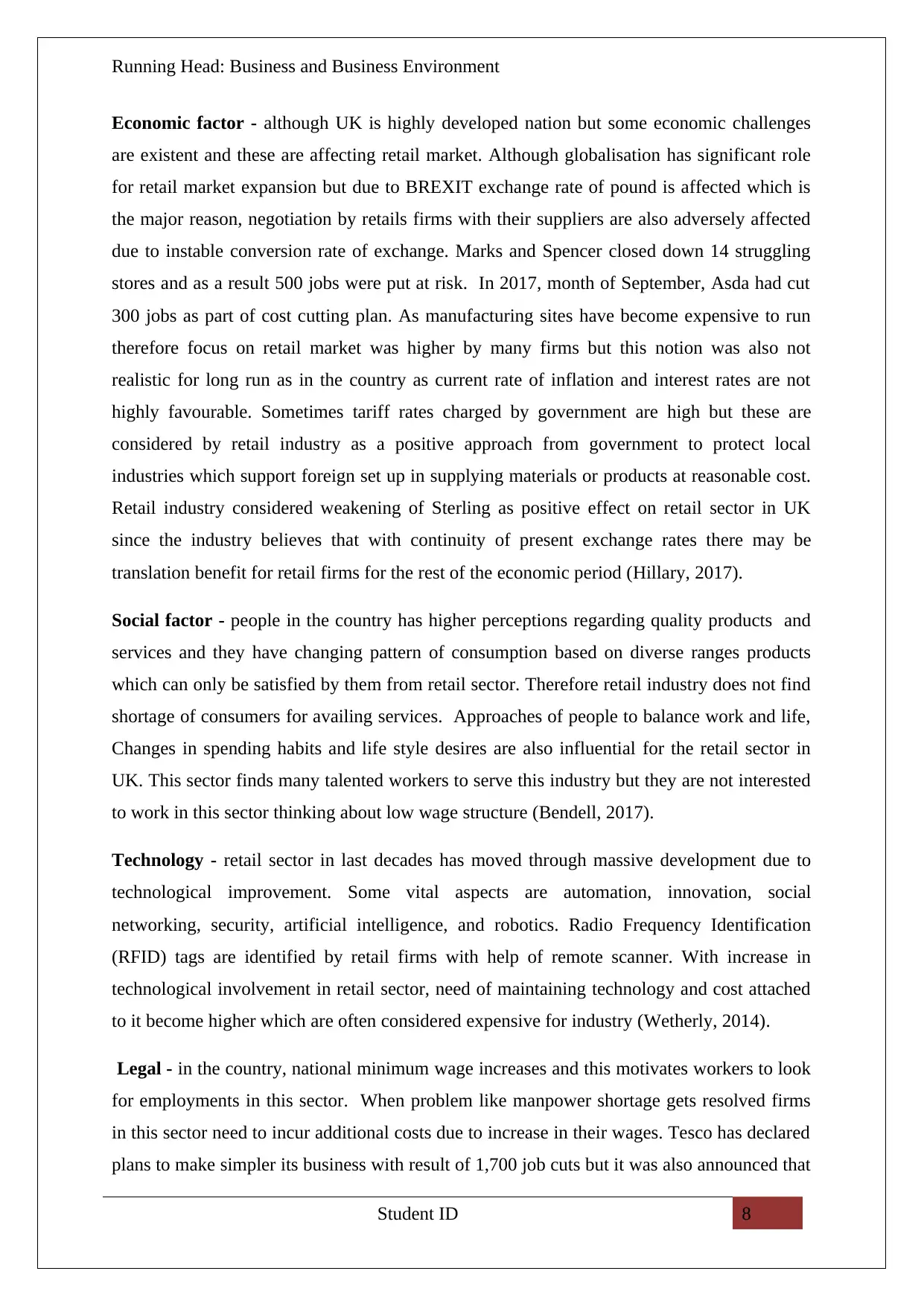
Running Head: Business and Business Environment
Economic factor - although UK is highly developed nation but some economic challenges
are existent and these are affecting retail market. Although globalisation has significant role
for retail market expansion but due to BREXIT exchange rate of pound is affected which is
the major reason, negotiation by retails firms with their suppliers are also adversely affected
due to instable conversion rate of exchange. Marks and Spencer closed down 14 struggling
stores and as a result 500 jobs were put at risk. In 2017, month of September, Asda had cut
300 jobs as part of cost cutting plan. As manufacturing sites have become expensive to run
therefore focus on retail market was higher by many firms but this notion was also not
realistic for long run as in the country as current rate of inflation and interest rates are not
highly favourable. Sometimes tariff rates charged by government are high but these are
considered by retail industry as a positive approach from government to protect local
industries which support foreign set up in supplying materials or products at reasonable cost.
Retail industry considered weakening of Sterling as positive effect on retail sector in UK
since the industry believes that with continuity of present exchange rates there may be
translation benefit for retail firms for the rest of the economic period (Hillary, 2017).
Social factor - people in the country has higher perceptions regarding quality products and
services and they have changing pattern of consumption based on diverse ranges products
which can only be satisfied by them from retail sector. Therefore retail industry does not find
shortage of consumers for availing services. Approaches of people to balance work and life,
Changes in spending habits and life style desires are also influential for the retail sector in
UK. This sector finds many talented workers to serve this industry but they are not interested
to work in this sector thinking about low wage structure (Bendell, 2017).
Technology - retail sector in last decades has moved through massive development due to
technological improvement. Some vital aspects are automation, innovation, social
networking, security, artificial intelligence, and robotics. Radio Frequency Identification
(RFID) tags are identified by retail firms with help of remote scanner. With increase in
technological involvement in retail sector, need of maintaining technology and cost attached
to it become higher which are often considered expensive for industry (Wetherly, 2014).
Legal - in the country, national minimum wage increases and this motivates workers to look
for employments in this sector. When problem like manpower shortage gets resolved firms
in this sector need to incur additional costs due to increase in their wages. Tesco has declared
plans to make simpler its business with result of 1,700 job cuts but it was also announced that
Student ID 8
Economic factor - although UK is highly developed nation but some economic challenges
are existent and these are affecting retail market. Although globalisation has significant role
for retail market expansion but due to BREXIT exchange rate of pound is affected which is
the major reason, negotiation by retails firms with their suppliers are also adversely affected
due to instable conversion rate of exchange. Marks and Spencer closed down 14 struggling
stores and as a result 500 jobs were put at risk. In 2017, month of September, Asda had cut
300 jobs as part of cost cutting plan. As manufacturing sites have become expensive to run
therefore focus on retail market was higher by many firms but this notion was also not
realistic for long run as in the country as current rate of inflation and interest rates are not
highly favourable. Sometimes tariff rates charged by government are high but these are
considered by retail industry as a positive approach from government to protect local
industries which support foreign set up in supplying materials or products at reasonable cost.
Retail industry considered weakening of Sterling as positive effect on retail sector in UK
since the industry believes that with continuity of present exchange rates there may be
translation benefit for retail firms for the rest of the economic period (Hillary, 2017).
Social factor - people in the country has higher perceptions regarding quality products and
services and they have changing pattern of consumption based on diverse ranges products
which can only be satisfied by them from retail sector. Therefore retail industry does not find
shortage of consumers for availing services. Approaches of people to balance work and life,
Changes in spending habits and life style desires are also influential for the retail sector in
UK. This sector finds many talented workers to serve this industry but they are not interested
to work in this sector thinking about low wage structure (Bendell, 2017).
Technology - retail sector in last decades has moved through massive development due to
technological improvement. Some vital aspects are automation, innovation, social
networking, security, artificial intelligence, and robotics. Radio Frequency Identification
(RFID) tags are identified by retail firms with help of remote scanner. With increase in
technological involvement in retail sector, need of maintaining technology and cost attached
to it become higher which are often considered expensive for industry (Wetherly, 2014).
Legal - in the country, national minimum wage increases and this motivates workers to look
for employments in this sector. When problem like manpower shortage gets resolved firms
in this sector need to incur additional costs due to increase in their wages. Tesco has declared
plans to make simpler its business with result of 1,700 job cuts but it was also announced that
Student ID 8
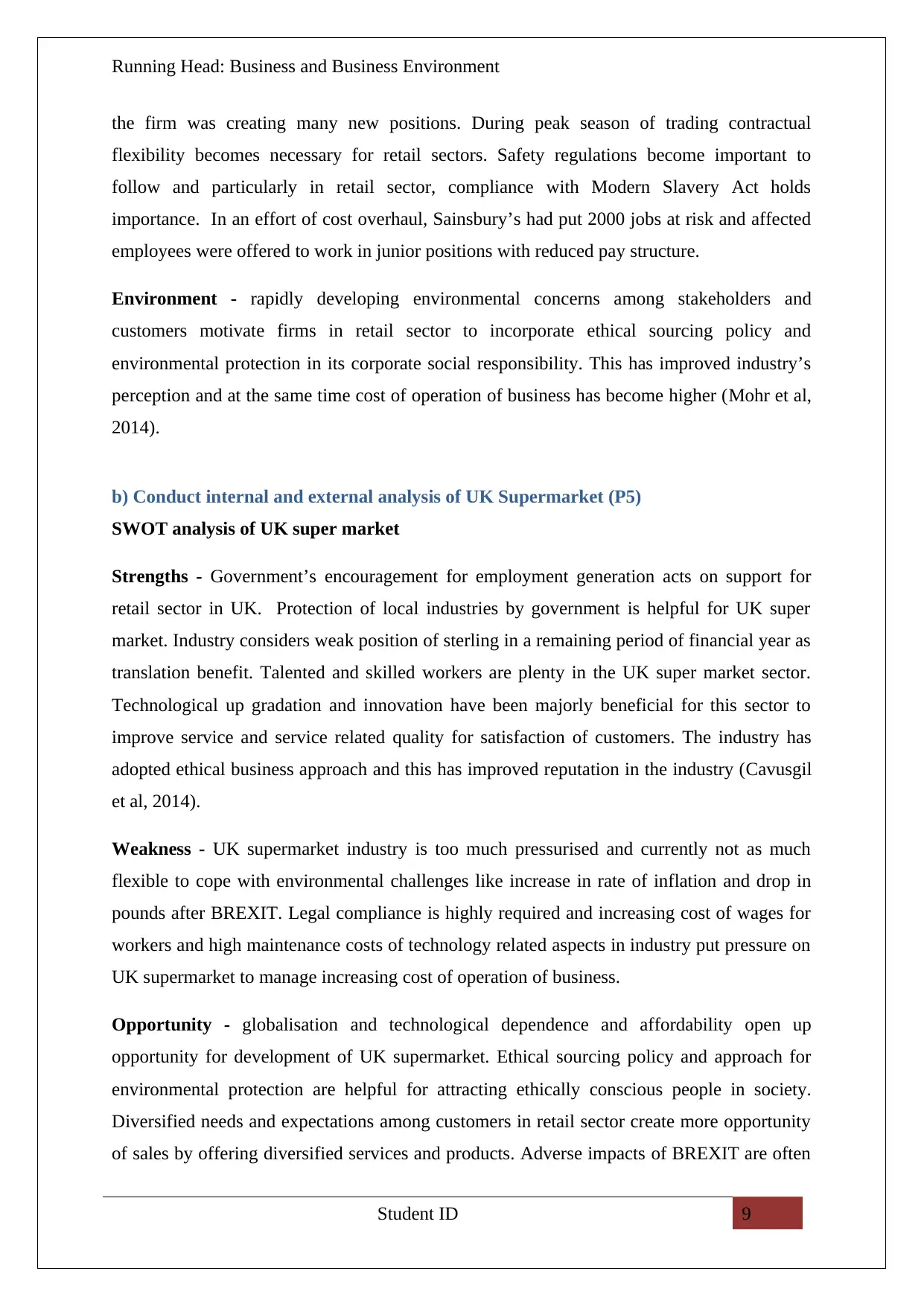
Running Head: Business and Business Environment
the firm was creating many new positions. During peak season of trading contractual
flexibility becomes necessary for retail sectors. Safety regulations become important to
follow and particularly in retail sector, compliance with Modern Slavery Act holds
importance. In an effort of cost overhaul, Sainsbury’s had put 2000 jobs at risk and affected
employees were offered to work in junior positions with reduced pay structure.
Environment - rapidly developing environmental concerns among stakeholders and
customers motivate firms in retail sector to incorporate ethical sourcing policy and
environmental protection in its corporate social responsibility. This has improved industry’s
perception and at the same time cost of operation of business has become higher (Mohr et al,
2014).
b) Conduct internal and external analysis of UK Supermarket (P5)
SWOT analysis of UK super market
Strengths - Government’s encouragement for employment generation acts on support for
retail sector in UK. Protection of local industries by government is helpful for UK super
market. Industry considers weak position of sterling in a remaining period of financial year as
translation benefit. Talented and skilled workers are plenty in the UK super market sector.
Technological up gradation and innovation have been majorly beneficial for this sector to
improve service and service related quality for satisfaction of customers. The industry has
adopted ethical business approach and this has improved reputation in the industry (Cavusgil
et al, 2014).
Weakness - UK supermarket industry is too much pressurised and currently not as much
flexible to cope with environmental challenges like increase in rate of inflation and drop in
pounds after BREXIT. Legal compliance is highly required and increasing cost of wages for
workers and high maintenance costs of technology related aspects in industry put pressure on
UK supermarket to manage increasing cost of operation of business.
Opportunity - globalisation and technological dependence and affordability open up
opportunity for development of UK supermarket. Ethical sourcing policy and approach for
environmental protection are helpful for attracting ethically conscious people in society.
Diversified needs and expectations among customers in retail sector create more opportunity
of sales by offering diversified services and products. Adverse impacts of BREXIT are often
Student ID 9
the firm was creating many new positions. During peak season of trading contractual
flexibility becomes necessary for retail sectors. Safety regulations become important to
follow and particularly in retail sector, compliance with Modern Slavery Act holds
importance. In an effort of cost overhaul, Sainsbury’s had put 2000 jobs at risk and affected
employees were offered to work in junior positions with reduced pay structure.
Environment - rapidly developing environmental concerns among stakeholders and
customers motivate firms in retail sector to incorporate ethical sourcing policy and
environmental protection in its corporate social responsibility. This has improved industry’s
perception and at the same time cost of operation of business has become higher (Mohr et al,
2014).
b) Conduct internal and external analysis of UK Supermarket (P5)
SWOT analysis of UK super market
Strengths - Government’s encouragement for employment generation acts on support for
retail sector in UK. Protection of local industries by government is helpful for UK super
market. Industry considers weak position of sterling in a remaining period of financial year as
translation benefit. Talented and skilled workers are plenty in the UK super market sector.
Technological up gradation and innovation have been majorly beneficial for this sector to
improve service and service related quality for satisfaction of customers. The industry has
adopted ethical business approach and this has improved reputation in the industry (Cavusgil
et al, 2014).
Weakness - UK supermarket industry is too much pressurised and currently not as much
flexible to cope with environmental challenges like increase in rate of inflation and drop in
pounds after BREXIT. Legal compliance is highly required and increasing cost of wages for
workers and high maintenance costs of technology related aspects in industry put pressure on
UK supermarket to manage increasing cost of operation of business.
Opportunity - globalisation and technological dependence and affordability open up
opportunity for development of UK supermarket. Ethical sourcing policy and approach for
environmental protection are helpful for attracting ethically conscious people in society.
Diversified needs and expectations among customers in retail sector create more opportunity
of sales by offering diversified services and products. Adverse impacts of BREXIT are often
Student ID 9
⊘ This is a preview!⊘
Do you want full access?
Subscribe today to unlock all pages.

Trusted by 1+ million students worldwide
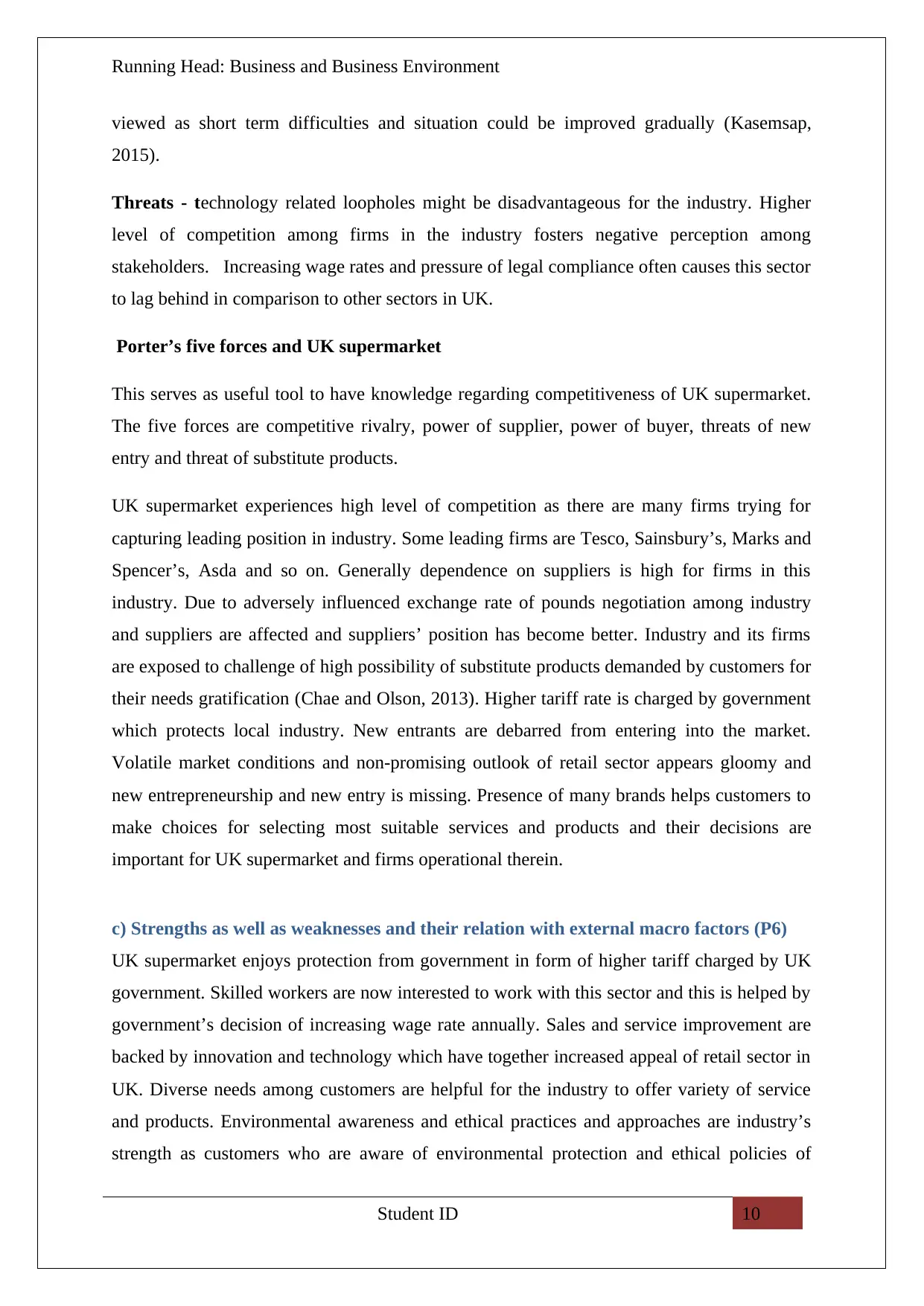
Running Head: Business and Business Environment
viewed as short term difficulties and situation could be improved gradually (Kasemsap,
2015).
Threats - technology related loopholes might be disadvantageous for the industry. Higher
level of competition among firms in the industry fosters negative perception among
stakeholders. Increasing wage rates and pressure of legal compliance often causes this sector
to lag behind in comparison to other sectors in UK.
Porter’s five forces and UK supermarket
This serves as useful tool to have knowledge regarding competitiveness of UK supermarket.
The five forces are competitive rivalry, power of supplier, power of buyer, threats of new
entry and threat of substitute products.
UK supermarket experiences high level of competition as there are many firms trying for
capturing leading position in industry. Some leading firms are Tesco, Sainsbury’s, Marks and
Spencer’s, Asda and so on. Generally dependence on suppliers is high for firms in this
industry. Due to adversely influenced exchange rate of pounds negotiation among industry
and suppliers are affected and suppliers’ position has become better. Industry and its firms
are exposed to challenge of high possibility of substitute products demanded by customers for
their needs gratification (Chae and Olson, 2013). Higher tariff rate is charged by government
which protects local industry. New entrants are debarred from entering into the market.
Volatile market conditions and non-promising outlook of retail sector appears gloomy and
new entrepreneurship and new entry is missing. Presence of many brands helps customers to
make choices for selecting most suitable services and products and their decisions are
important for UK supermarket and firms operational therein.
c) Strengths as well as weaknesses and their relation with external macro factors (P6)
UK supermarket enjoys protection from government in form of higher tariff charged by UK
government. Skilled workers are now interested to work with this sector and this is helped by
government’s decision of increasing wage rate annually. Sales and service improvement are
backed by innovation and technology which have together increased appeal of retail sector in
UK. Diverse needs among customers are helpful for the industry to offer variety of service
and products. Environmental awareness and ethical practices and approaches are industry’s
strength as customers who are aware of environmental protection and ethical policies of
Student ID 10
viewed as short term difficulties and situation could be improved gradually (Kasemsap,
2015).
Threats - technology related loopholes might be disadvantageous for the industry. Higher
level of competition among firms in the industry fosters negative perception among
stakeholders. Increasing wage rates and pressure of legal compliance often causes this sector
to lag behind in comparison to other sectors in UK.
Porter’s five forces and UK supermarket
This serves as useful tool to have knowledge regarding competitiveness of UK supermarket.
The five forces are competitive rivalry, power of supplier, power of buyer, threats of new
entry and threat of substitute products.
UK supermarket experiences high level of competition as there are many firms trying for
capturing leading position in industry. Some leading firms are Tesco, Sainsbury’s, Marks and
Spencer’s, Asda and so on. Generally dependence on suppliers is high for firms in this
industry. Due to adversely influenced exchange rate of pounds negotiation among industry
and suppliers are affected and suppliers’ position has become better. Industry and its firms
are exposed to challenge of high possibility of substitute products demanded by customers for
their needs gratification (Chae and Olson, 2013). Higher tariff rate is charged by government
which protects local industry. New entrants are debarred from entering into the market.
Volatile market conditions and non-promising outlook of retail sector appears gloomy and
new entrepreneurship and new entry is missing. Presence of many brands helps customers to
make choices for selecting most suitable services and products and their decisions are
important for UK supermarket and firms operational therein.
c) Strengths as well as weaknesses and their relation with external macro factors (P6)
UK supermarket enjoys protection from government in form of higher tariff charged by UK
government. Skilled workers are now interested to work with this sector and this is helped by
government’s decision of increasing wage rate annually. Sales and service improvement are
backed by innovation and technology which have together increased appeal of retail sector in
UK. Diverse needs among customers are helpful for the industry to offer variety of service
and products. Environmental awareness and ethical practices and approaches are industry’s
strength as customers who are aware of environmental protection and ethical policies of
Student ID 10
Paraphrase This Document
Need a fresh take? Get an instant paraphrase of this document with our AI Paraphraser
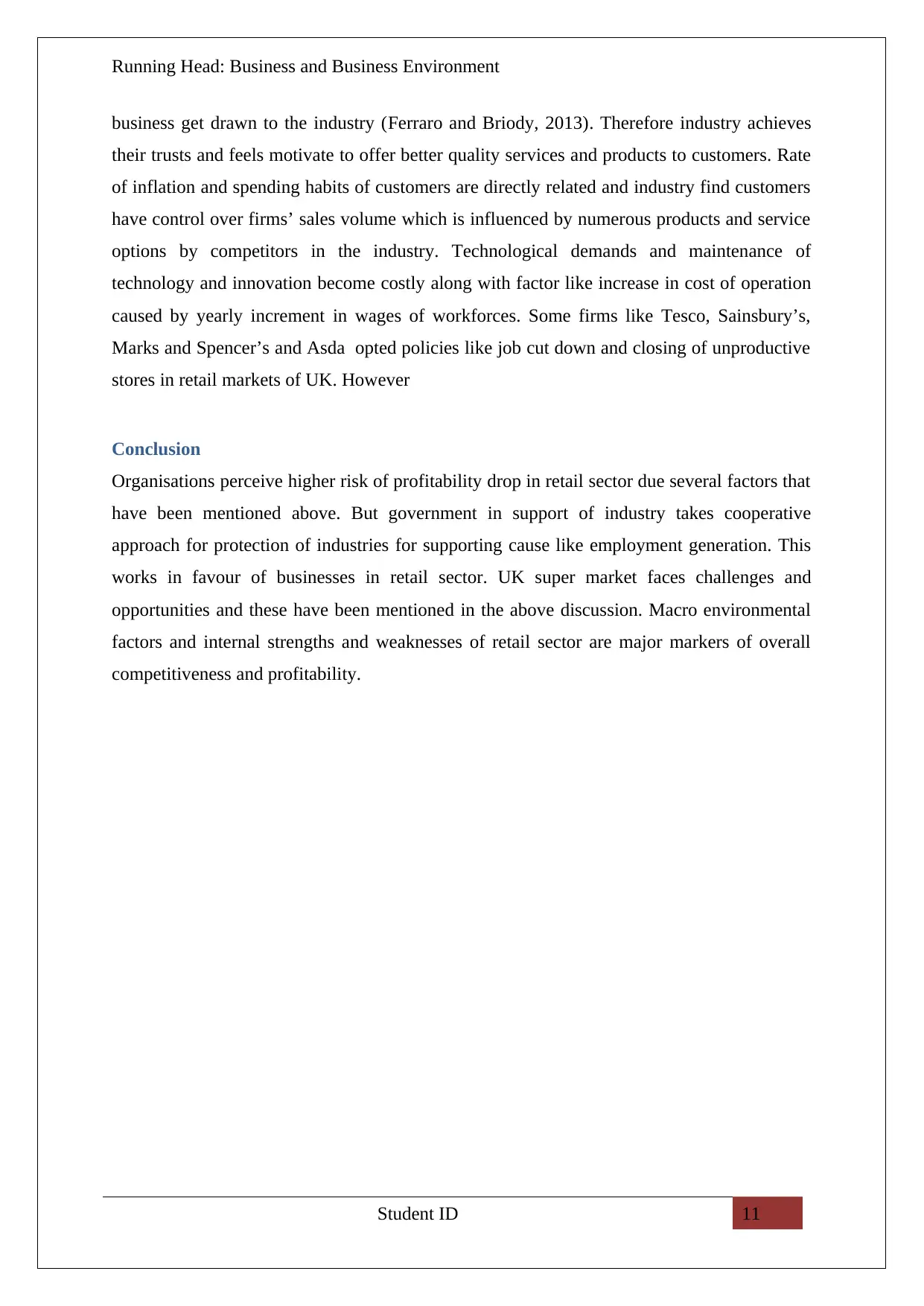
Running Head: Business and Business Environment
business get drawn to the industry (Ferraro and Briody, 2013). Therefore industry achieves
their trusts and feels motivate to offer better quality services and products to customers. Rate
of inflation and spending habits of customers are directly related and industry find customers
have control over firms’ sales volume which is influenced by numerous products and service
options by competitors in the industry. Technological demands and maintenance of
technology and innovation become costly along with factor like increase in cost of operation
caused by yearly increment in wages of workforces. Some firms like Tesco, Sainsbury’s,
Marks and Spencer’s and Asda opted policies like job cut down and closing of unproductive
stores in retail markets of UK. However
Conclusion
Organisations perceive higher risk of profitability drop in retail sector due several factors that
have been mentioned above. But government in support of industry takes cooperative
approach for protection of industries for supporting cause like employment generation. This
works in favour of businesses in retail sector. UK super market faces challenges and
opportunities and these have been mentioned in the above discussion. Macro environmental
factors and internal strengths and weaknesses of retail sector are major markers of overall
competitiveness and profitability.
Student ID 11
business get drawn to the industry (Ferraro and Briody, 2013). Therefore industry achieves
their trusts and feels motivate to offer better quality services and products to customers. Rate
of inflation and spending habits of customers are directly related and industry find customers
have control over firms’ sales volume which is influenced by numerous products and service
options by competitors in the industry. Technological demands and maintenance of
technology and innovation become costly along with factor like increase in cost of operation
caused by yearly increment in wages of workforces. Some firms like Tesco, Sainsbury’s,
Marks and Spencer’s and Asda opted policies like job cut down and closing of unproductive
stores in retail markets of UK. However
Conclusion
Organisations perceive higher risk of profitability drop in retail sector due several factors that
have been mentioned above. But government in support of industry takes cooperative
approach for protection of industries for supporting cause like employment generation. This
works in favour of businesses in retail sector. UK super market faces challenges and
opportunities and these have been mentioned in the above discussion. Macro environmental
factors and internal strengths and weaknesses of retail sector are major markers of overall
competitiveness and profitability.
Student ID 11
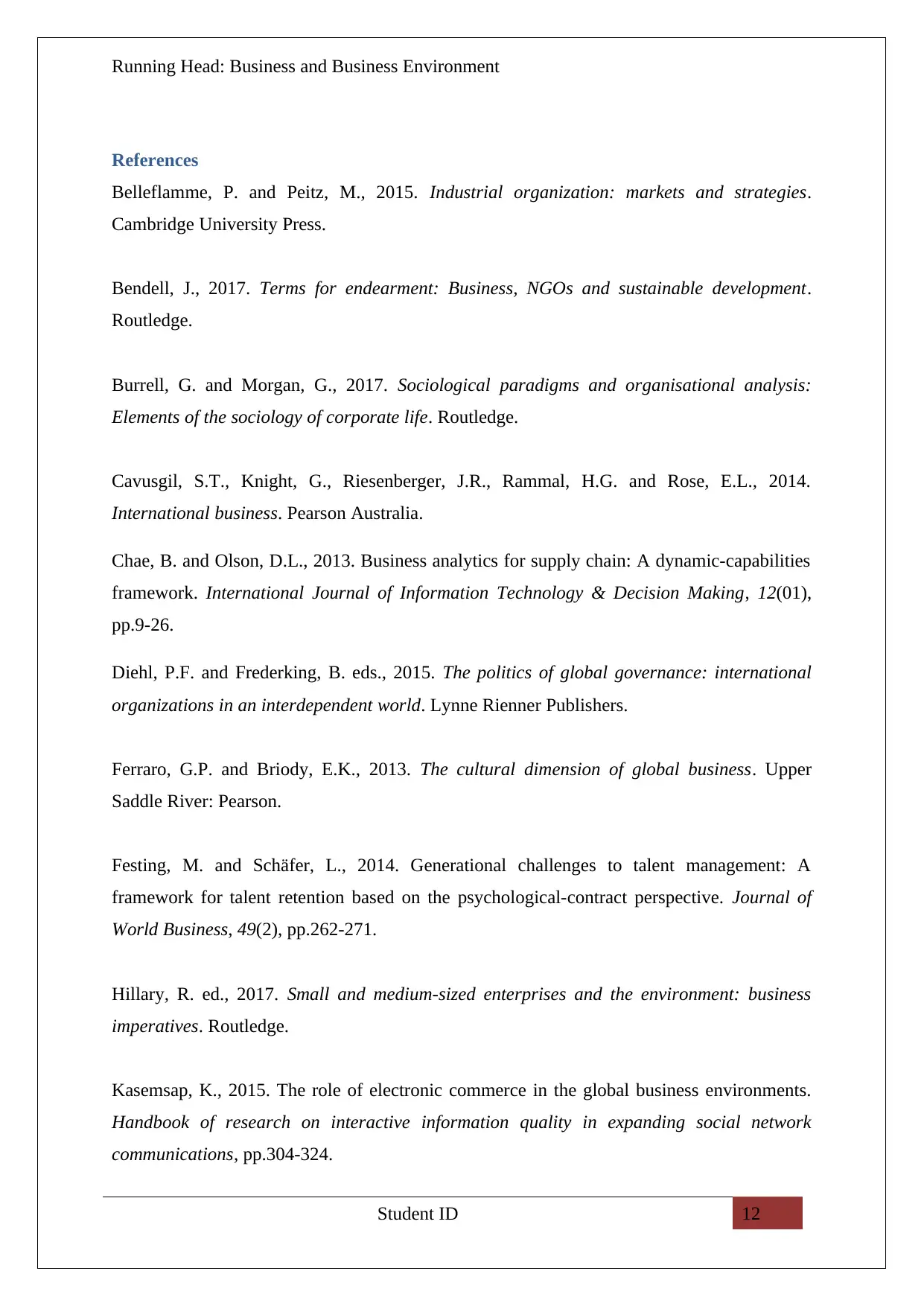
Running Head: Business and Business Environment
References
Belleflamme, P. and Peitz, M., 2015. Industrial organization: markets and strategies.
Cambridge University Press.
Bendell, J., 2017. Terms for endearment: Business, NGOs and sustainable development.
Routledge.
Burrell, G. and Morgan, G., 2017. Sociological paradigms and organisational analysis:
Elements of the sociology of corporate life. Routledge.
Cavusgil, S.T., Knight, G., Riesenberger, J.R., Rammal, H.G. and Rose, E.L., 2014.
International business. Pearson Australia.
Chae, B. and Olson, D.L., 2013. Business analytics for supply chain: A dynamic-capabilities
framework. International Journal of Information Technology & Decision Making, 12(01),
pp.9-26.
Diehl, P.F. and Frederking, B. eds., 2015. The politics of global governance: international
organizations in an interdependent world. Lynne Rienner Publishers.
Ferraro, G.P. and Briody, E.K., 2013. The cultural dimension of global business. Upper
Saddle River: Pearson.
Festing, M. and Schäfer, L., 2014. Generational challenges to talent management: A
framework for talent retention based on the psychological-contract perspective. Journal of
World Business, 49(2), pp.262-271.
Hillary, R. ed., 2017. Small and medium-sized enterprises and the environment: business
imperatives. Routledge.
Kasemsap, K., 2015. The role of electronic commerce in the global business environments.
Handbook of research on interactive information quality in expanding social network
communications, pp.304-324.
Student ID 12
References
Belleflamme, P. and Peitz, M., 2015. Industrial organization: markets and strategies.
Cambridge University Press.
Bendell, J., 2017. Terms for endearment: Business, NGOs and sustainable development.
Routledge.
Burrell, G. and Morgan, G., 2017. Sociological paradigms and organisational analysis:
Elements of the sociology of corporate life. Routledge.
Cavusgil, S.T., Knight, G., Riesenberger, J.R., Rammal, H.G. and Rose, E.L., 2014.
International business. Pearson Australia.
Chae, B. and Olson, D.L., 2013. Business analytics for supply chain: A dynamic-capabilities
framework. International Journal of Information Technology & Decision Making, 12(01),
pp.9-26.
Diehl, P.F. and Frederking, B. eds., 2015. The politics of global governance: international
organizations in an interdependent world. Lynne Rienner Publishers.
Ferraro, G.P. and Briody, E.K., 2013. The cultural dimension of global business. Upper
Saddle River: Pearson.
Festing, M. and Schäfer, L., 2014. Generational challenges to talent management: A
framework for talent retention based on the psychological-contract perspective. Journal of
World Business, 49(2), pp.262-271.
Hillary, R. ed., 2017. Small and medium-sized enterprises and the environment: business
imperatives. Routledge.
Kasemsap, K., 2015. The role of electronic commerce in the global business environments.
Handbook of research on interactive information quality in expanding social network
communications, pp.304-324.
Student ID 12
⊘ This is a preview!⊘
Do you want full access?
Subscribe today to unlock all pages.

Trusted by 1+ million students worldwide
1 out of 13
Related Documents
Your All-in-One AI-Powered Toolkit for Academic Success.
+13062052269
info@desklib.com
Available 24*7 on WhatsApp / Email
![[object Object]](/_next/static/media/star-bottom.7253800d.svg)
Unlock your academic potential
Copyright © 2020–2025 A2Z Services. All Rights Reserved. Developed and managed by ZUCOL.





